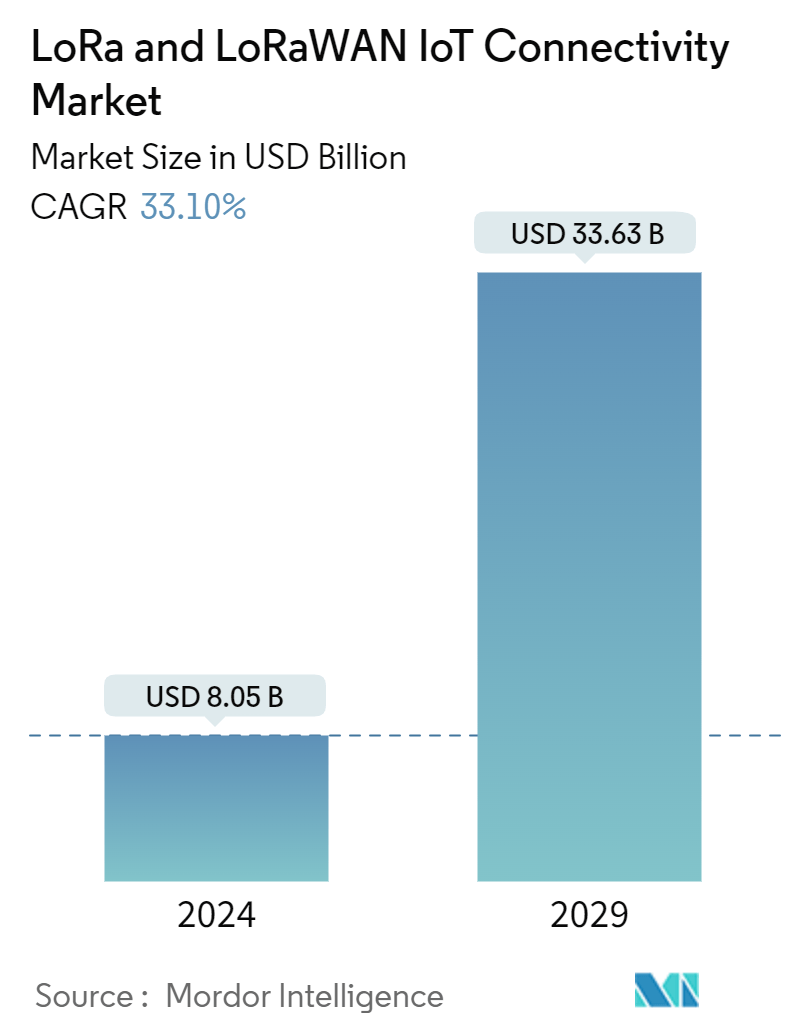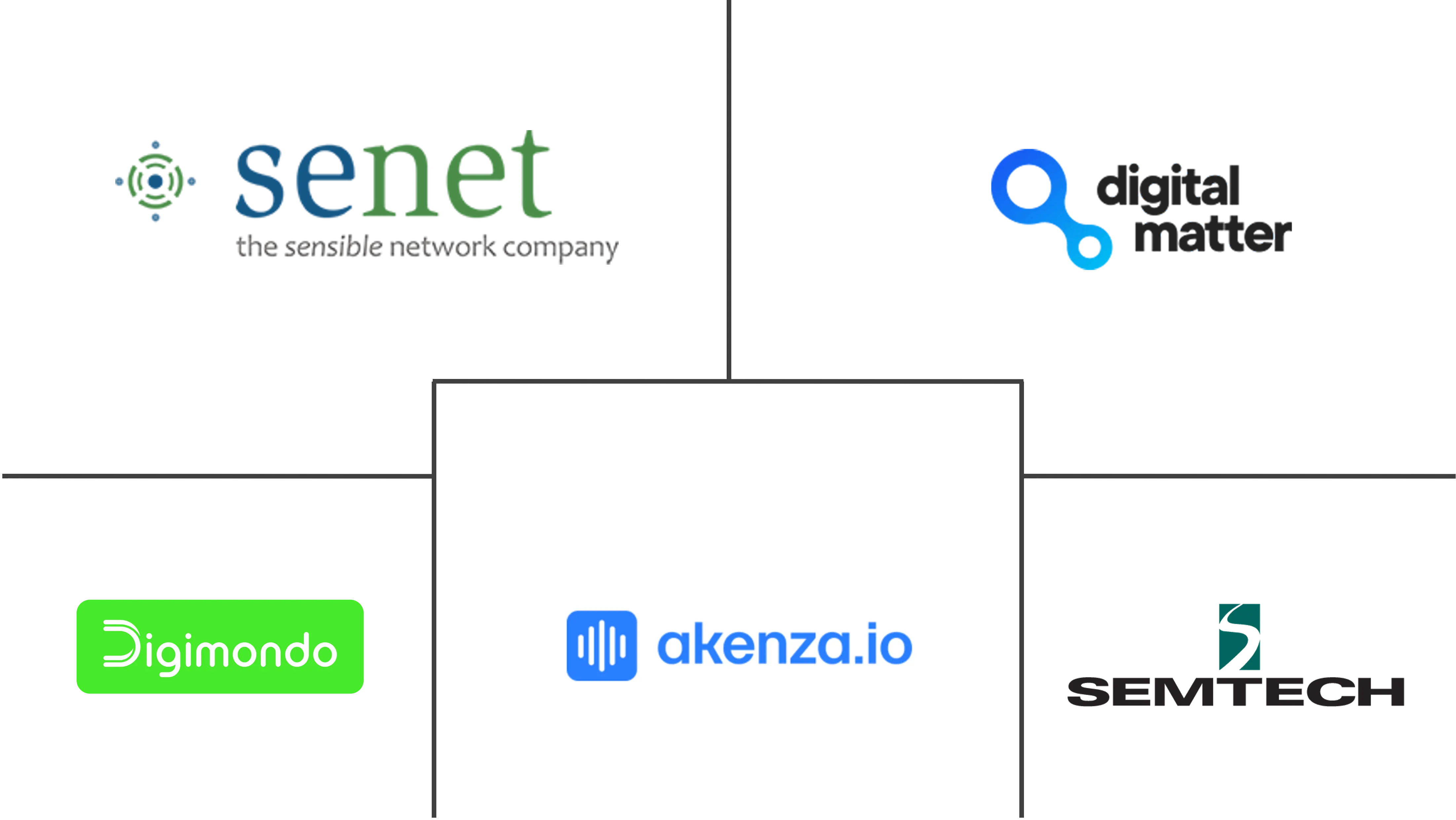Market Size of LoRa And LoRaWAN IoT Connectivity Industry

| Study Period | 2019 - 2029 |
| Market Size (2024) | USD 8.05 Billion |
| Market Size (2029) | USD 33.63 Billion |
| CAGR (2024 - 2029) | 33.10 % |
| Fastest Growing Market | Asia Pacific |
| Largest Market | North America |
| Market Concentration | Medium |
Major Players
*Disclaimer: Major Players sorted in no particular order |
LoRa And LoRaWAN IoT Connectivity Market Analysis
The LoRa And LoRaWAN IoT Connectivity Market size is estimated at USD 8.05 billion in 2024, and is expected to reach USD 33.63 billion by 2029, growing at a CAGR of 33.10% during the forecast period (2024-2029).
LoRa and LoRaWAN technologies are gaining traction in the IoT market, primarily due to their affordability and scalability. LoRa's simple hardware requirements and efficient communication protocols make it a standout choice for developing affordable IoT devices and sensors. This affordability expands the adoption of IoT solutions, enhancing their accessibility across various industries. Such accessibility is particularly beneficial for sectors constrained by budget or resources.
• LoRaWAN's architecture is lauded for its seamless scalability, enabling the deployment of IoT networks ranging from thousands to millions of devices. This scalability is crucial for IoT applications requiring extensive coverage, notably in smart cities, industrial automation, and supply chain management sectors. The combination of cost-effective device development and the ability to scale networks positions LoRa and LoRaWAN as key enablers of IoT adoption, driving their penetration across diverse sectors.
• NEOM City, under construction in Saudi Arabia, is poised to become a leading smart city. By 2030, it's projected to accommodate 200 million IoT devices. In July 2023, TONOMUS, NEOM's cognitive technology arm, unveiled its inaugural digital communications hub. This center is designed to support a software-centric network and a secure private cloud, catering not only to 60 locations but also to around 1,800 structures. It's a crucial infrastructure, especially given NEOM's ambitious plans, which include hosting an estimated 300,000 construction personnel by 2025 and those above 200 million IoT devices by 2030.
• LoRa and LoRaWAN technologies are pivotal in the realm of Industrial IoT. They empower large industrial segments to swiftly adapt, reduce operational costs, enhance worker safety, and bolster environmental and social governance. This adaptability is crucial for these industries to survive and grow in an increasingly digital landscape. In the LoRaWAN setup, gateways are strategically placed on-site. A single gateway can cover a modest terminal, and when combined with tens of thousands of IoT sensors, they form a robust network. This network ownership grants the IT department unparalleled control over its parameters. Moreover, a well-executed wireless deployment using LoRa and LoRaWAN ensures seamless infrastructure expansion or redeployment, minimizing operational disruptions.
• LoRa technology, though effective for low data rate applications, faces bandwidth constraints compared to its wireless counterparts. This limitation proves challenging for applications demanding high data throughput. In areas densely populated with LoRaWAN or other wireless networks, interference and congestion can arise, potentially hampering the reliability and performance of device-to-gateway communications.
• LoRaWAN routing encounters numerous challenges. A primary issue arises from its restricted one-hop communication range between end nodes and gateways. This limitation is especially troublesome in regions with spotty internet coverage or radio-hostile environments. Additionally, extended links face the risk of obstacles and interference, potentially hampering packet reception. Furthermore, ensuring data security and privacy is a pivotal hurdle in the widespread acceptance of LoRaWAN technologies.
LoRa And LoRaWAN IoT Connectivity Industry Segmentation
LoRa serves as the data-carrying radio signal, while LoRaWAN is the communication protocol dictating how this data traverses the network. LoRaWAN's primary advantages lie in its ability to offer energy-efficient, extensive coverage, and cost-effective connectivity. It particularly shines for devices with modest data needs, proving especially valuable in scenarios where cellular connectivity is prohibitively expensive or Wi-Fi signals are absent.
The report covers LoRa and LoRaWAN market companies, and the market is segmented by offering (hardware, IoT software/platform, services), by size (small and medium enterprises, large enterprises), by industry vertical (healthcare, transportation and logistics, government and public sector, retail and e-commerce, manufacturing, energy and utilities, other industry verticals), and by region (North America, Europe, Asia-Pacific, Rest of the World).
The report offers market sizes and forecasts in value (USD) for all the above segments.
| By Offering | |
| Hardware | |
| IoT Software/Platform | |
| Services |
| By Size of Enterprise | |
| Small and Medium Enterprises | |
| Large Enterprises |
| By Industry Vertical | |
| Healthcare | |
| Transportation and Logistics | |
| Government and Public Sector | |
| Retail and E-commerce | |
| Manufacturing | |
| Energy and Utilities | |
| Other Industry Verticals |
| By Geography | |
| North America | |
| Europe | |
| Asia-Pacific | |
| Rest of the World |
LoRa And LoRaWAN IoT Connectivity Market Size Summary
The LoRa and LoRaWAN IoT Connectivity Market is experiencing significant growth, driven by the technologies' affordability and scalability. These attributes make LoRa and LoRaWAN attractive for developing cost-effective IoT devices and sensors, facilitating broader adoption across various industries. The architecture of LoRaWAN is particularly noted for its ability to scale seamlessly, supporting the deployment of extensive IoT networks essential for applications in smart cities, industrial automation, and supply chain management. This scalability, combined with the cost-effective development of devices, positions LoRa and LoRaWAN as pivotal enablers of IoT adoption, enhancing their penetration across diverse sectors. The technologies are also crucial in the Industrial IoT space, allowing industries to adapt quickly, reduce costs, and improve operational efficiencies.
The market landscape is characterized by a fragmented nature, with key players like Senet, Semtech Corporation, and Akenza AG actively engaging in partnerships, innovations, and acquisitions to strengthen their market position. Recent developments include AWS's introduction of LoRaWAN support on its public network in Spain, enabling seamless integration of LoRaWAN devices with cloud services. Additionally, Avnet's IoTConnect update now supports LoRaWAN and Amazon Sidewalk, enhancing device connectivity. The market is further bolstered by advancements in Industry 4.0, with significant investments aimed at digital transformation in manufacturing and logistics. These trends underscore the growing importance of LoRa and LoRaWAN technologies in facilitating smart city initiatives, industrial automation, and asset tracking, driving the market's expansion.
LoRa And LoRaWAN IoT Connectivity Market Size - Table of Contents
-
1. MARKET INSIGHTS
-
1.1 Market Overview
-
1.2 Analysis of Macro-Economic Scenarios (Recession, Russia-Ukraine Crisis, etc.)
-
-
2. MARKET SEGMENTATION
-
2.1 By Offering
-
2.1.1 Hardware
-
2.1.2 IoT Software/Platform
-
2.1.3 Services
-
-
2.2 By Size of Enterprise
-
2.2.1 Small and Medium Enterprises
-
2.2.2 Large Enterprises
-
-
2.3 By Industry Vertical
-
2.3.1 Healthcare
-
2.3.2 Transportation and Logistics
-
2.3.3 Government and Public Sector
-
2.3.4 Retail and E-commerce
-
2.3.5 Manufacturing
-
2.3.6 Energy and Utilities
-
2.3.7 Other Industry Verticals
-
-
2.4 By Geography
-
2.4.1 North America
-
2.4.2 Europe
-
2.4.3 Asia-Pacific
-
2.4.4 Rest of the World
-
-
LoRa And LoRaWAN IoT Connectivity Market Size FAQs
How big is the LoRa And LoRaWAN IoT Connectivity Market?
The LoRa And LoRaWAN IoT Connectivity Market size is expected to reach USD 8.05 billion in 2024 and grow at a CAGR of 33.10% to reach USD 33.63 billion by 2029.
What is the current LoRa And LoRaWAN IoT Connectivity Market size?
In 2024, the LoRa And LoRaWAN IoT Connectivity Market size is expected to reach USD 8.05 billion.

